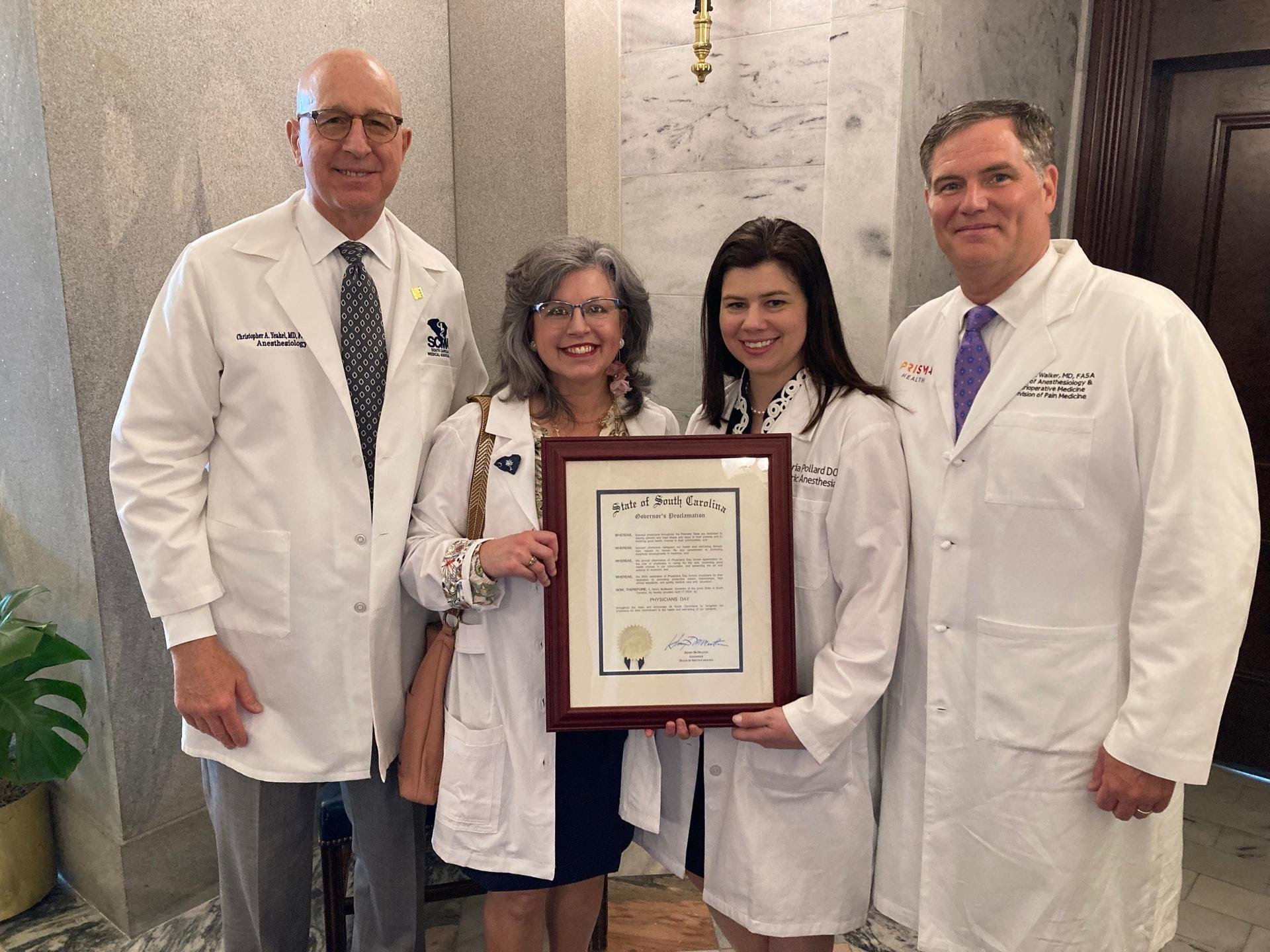Become a Member
What is Chronic Pain?
While acute pain is a normal sensation triggered in the nervous system to alert you to possible injury and the need to take care of yourself, chronic pain is different. Chronic pain persists. Pain signals keep firing in the nervous system for weeks, months, even years.
There may have been an initial mishap -- sprained back, serious infection, or there may be an ongoing cause of pain – arthritis, cancer, ear infection, but some people suffer chronic pain in the absence of any past injury or evidence of body damage. Many chronic pain conditions affect older adults. Common chronic pain complaints include headache, low back pain, cancer pain, arthritis pain, neurogenic pain (pain resulting from damage to the peripheral nerves or to the central nervous system itself).
– American Academy of Pain Medicine
Definition of Pain Medicine
The specialty of Pain Medicine, or Algiatry, is a discipline within the field of medicine that is concerned with the prevention of pain, and the evaluation, treatment, and rehabilitation of persons in pain. Some conditions may have pain and associated symptoms arising from a discrete cause, such as postoperative pain or pain associated with a malignancy, or may be conditions in which pain constitutes the primary problem, such as neuropathic pains or headaches.
Pain Medicine Specialists use a broad-based approach to treat all pain disorders, ranging from pain as a symptom of disease to pain as the primary disease. The pain physician serves as a consultant to other physicians but is often the principal treating physician (as distinguished from the primary care physician) and may provide care at various levels, such as treating the patient directly, prescribing medication, prescribing rehabilitative services, performing pain relieving procedures, counseling patients and families, directing a multidisciplinary team, coordinating care with other health care providers and providing consultative services to public and private agencies pursuant to optimal health care delivery to the patient suffering from pain.
The objective of the pain physician is to provide quality care to the patient suffering from pain. The pain physician may work in a variety of settings and is competent to treat the entire range of pain encountered in delivery of quality health care.
– American Board of Pain Medicine
Opioid FAQs
“Opioids” are substances that act on the central nervous system to relieve pain. They also act on other areas of the body such as the gray matter in the brain, the endocrine system, and the GI tract. These are drugs like Vicodin©(Hydrocodone), Percocet©(Oxycodone), Morphine, etc.
In early 2016, the US Surgeon General, VH Murthy M.D., MBA wrote a letter to all US physicians asking for help in “turning the tide” on the opioid epidemic that our nation is facing. (See contents of the letter here: http://turnthetiderx.org). In this letter, he noted that since 1999 there had been a 300% increase in opioid prescription sales without an overall change in the amount of pain that people were experiencing. In this letter, he asked physicians to do 3 things:
· Educate ourselves to treat pain safely and effectively.
· Screen our patients for opioid use disorder and provide or connect them with evidence-based treatment.
· Talk about and treat addiction as a chronic illness, not a moral failing.
The letter was unprecedented in terms of its outreach and its potential impact on patient’s suffering with chronic pain. I have always believed in using a “multimodal” approach to treatment. In doing so, I have followed what has been the “standard of care” since the mid-1990s. Because I have always been in the business of trying to help patients live as healthy and active a lifestyle as possible, I have never relied solely on opioid therapy for management of chronic pain conditions. I have always strived to engage our patients actively in their treatments, and in doing so have helped them to minimize their reliance on opioids by utilizing other treatment modalities such as physical therapy, chiropractic therapy, acupuncture, image-guided injection therapy, spinal cord stimulation therapy and radiofrequency ablation. This conservative approach has helped me to avoid “high-dose opioid therapy” for most of my patients.
The problem with opioids is that our bodies were not designed to have a constant supply of opioids in them. While it is true that the body makes its own opioids (endogenous opioids) in times of stress or injury, these levels typically go down quite quickly as the body returns to normal. While we did not think that there were any significant long-term risks to taking opioids back in the 1980s and 1990s (other than the well-known side effects and risks of constipation, itching, nausea, and slowing down of breathing) we are now finding out that there are indeed potential long-term risks associated with taking chronic opioids.
As noted above, we have known for a long time that the risks of constipation, itching, nausea, and slowing down of breathing exist for all patients taking opioids. More recently, and more
concerning recent studies have been published showing the following potential risks of taking chronic opioids:
· Long-term opioid use increase depression risks (Annals of Family Medicine 2016; 14: 54–62)
· 1 month of opioid use causes gray matter (brain) loss, new study confirms (Pain Medicine 2015, December 26)
· “Although prescribing benzodiazepines, currently with opioid analgesics has been shown to raise the risk of fatal overdose, new research documents a risk that is 4 times that of opioids taken alone, even at low doses.” (British Medical Journal 2015; 350: H2698)
· Opioid analgesics subpar for chronic back pain (Marcia Frellick June 3, 2016)
· “Opioid use in older drivers double the risk for single vehicle crash.” (Clinical Essentials from Age Aging August 10, 2016)
· “Compared with nonuse, long-term opioid use was associated with increased use of medications for erectile dysfunction or testosterone replacement” (Annals of Internal Medicine February 17, 2015)
· “Recent studies have found that doses of morphine over 50 mg double the risk of fractures in the elderly, with an annual fracture rate of 9.95% “(Prim Care Companion CNS Disorder. 2012; 14 (3)
· “For older adults taking long-acting opioids, the odds of contracting community acquired pneumonia was 3.43 times higher than non-users” (J Am Geriatr Soc. 2011 October; 59 (10): 1899–907)
· CDC reports: “Opioid-related deaths at all-time high... With an increase of nearly 5000 deaths from 2014-2015. Overdose deaths in the US rose 11% last year to 52,404.” (Washington Post December 9, 2016)
It certainly does. The examples above are just a small sample of the literature that has come out in the past 2–3 years arguing against the use of opioids for treatment of chronic pain. Now, more than ever, with the additional information that we have at hand, we need to carefully consider whether to use opioids at all when managing chronic pain. While on the one hand we very much want patients to be able to function as well as possible in the setting of chronic pain, on the other hand, we do not want the very medications that we are using to try to treat pain make a patient’s overall health suffer. The answer to the question, “Should we be using opioids at all to treat chronic pain?” is a very complex one, that needs to be considered very carefully in each individual patient.
The FDA recently issued a "black box" warning regarding the combined use of a drug class called benzodiazepines. Benzodiazepines include drugs such as Xanax (alprazolam), Ativan (lorazepam) and Klonopin (clonazepam). The FDA found that patients who were taking medications from both classes of drugs were at an increased risk of breathing difficulties and death. The FDA has recommended not using both medications together. Further, evidence shows that this risk is increased in the elderly. Just because a patient has not had any problems with treatment in the past does not mean that future problems cannot occur.
No, it does not. Even if a person has been taking an opioid for many years, it does not mean that they are “addicted” to the medication. Long-term use of opioids does, however, typically lead to a “physical dependence” on them which is very different from addiction. If a person who has been on chronic opioids decides to discontinue them, they should never do so abruptly because it will lead to a withdrawal syndrome which will be very uncomfortable and potentially harmful to a person’s health. Typically, if the opioids are tapered off over several weeks to months, it can be done safely, without a significant amount of risk.
No, it typically does not. Most of the time this can be achieved slowly, under the close supervision of a medical professional without the need to go into a “detox” program. As noted above since we are typically not dealing with an “addiction” problem but more of a “physical dependence” problem the process is usually much less complicated.
That is a good question and one that will have a different answer for each individual person. Thankfully, since there had been several advancements in the treatment of chronic pain over the past 10 years, there may be options that were not originally available. The first step is asking “What else can be done?”
At this point in time, I have no plans or desire to stop prescribing opioids for patients who need them, and who are taking them in a reliable fashion, with minimal side effects, and good overall effect on activity levels and quality-of-life. However, considering the national opioid crisis, as well as the emerging clinical data regarding the effects of chronic opioid therapy on the body, I am trying to reevaluate each patient’s specific care plan to determine or not opioids are needed/justified. When opioids are needed, what the lowest dose and safest form of opioid therapy are. Whether a patient who is taking opioids believes that opioids are providing a reasonable balance between “risks vs. benefits” in terms of quality of life and overall health and wellbeing.
In the past, we have used opioid rotation --- switching from one opioid to another--- as means of continuing the patient on opioid therapy without having to continually escalate the dosage of one medication. While this strategy may still have some clinical utility in certain cases, it ignores the point of the whole discussion about the appropriateness of opioids for treatment of chronic pain by adopting this strategy we are simply “kicking the can down the road” regarding the question of the appropriateness of long-term opioid therapy for treatment of chronic pain.
As part of your care plan, if you are receiving opioid therapy you will continue to be seen on a regular basis, as usual. This FAQ sheet is not meant to alarm you. We are hoping that as you read this FAQ sheet it will raise some questions in your mind about the “pros and cons” of chronic opioid therapy and how it relates to your long-term health. At this very moment, several different pharmaceutical companies are working on new non-opioid medications for treatment of chronic pain. The “silver lining” to this “opioid storm cloud” is that, along with the concerning news that we have about the potential negative effects of opioids in the human body, we are also discovering new ways that pain can be treated without the use of opioids.
Pain Medicine FAQs
If you have been experiencing this pain most days or every day for six months or more, that is chronic pain.
Chronic pain is usually caused by an injury or a separate, underlying health condition. The most common are back pain, arthritis, and migraine and headache disorders.
There is post-op pain, which is the pain you may experience after having surgery. Surgery for broken bones and abdominal surgeries can be very painful during the recovery period. There is also the pain of certain diseases, like cancer. Yes, acute and terminal pain can be treated.
A pain medicine specialist is an expert in pain itself. These medical doctors have additional training and education in diagnosing and treating pain conditions. Neurologists, internists and family medicine physicians may also be able to treat you. Be sure to ask if they treat pain patients in their practice.
Pain can definitely affect your mood and stress levels, and likewise, your mood and stress levels can affect your pain. Discuss this with your pain physician and ask if a support group or experienced counselor should be a part of your treatment plan.
Consider finding a clinical trial. These research studies often provide patients with access to cutting-edge therapies that are not available to the general public
Contact the Pain Society of the Carolinas for a list of pain medicine specialists in your area. www.carolinapain.org




